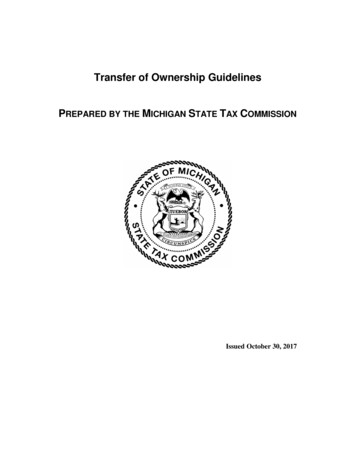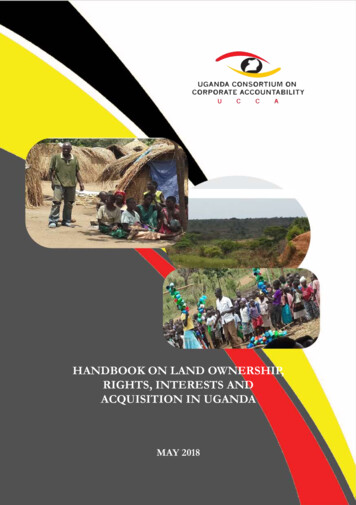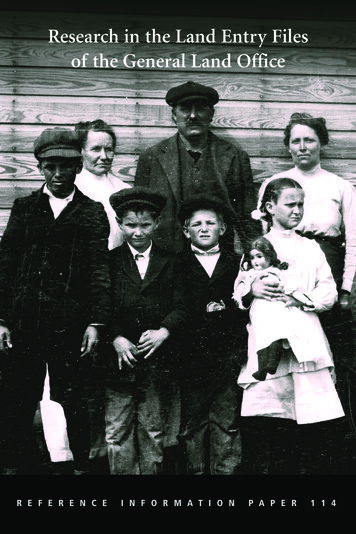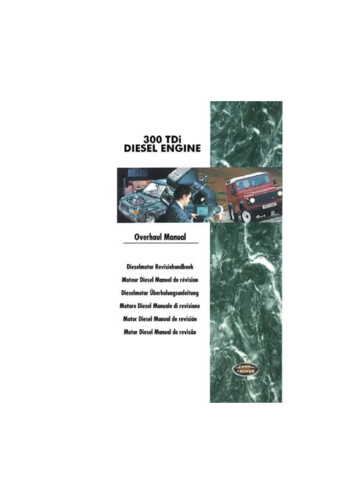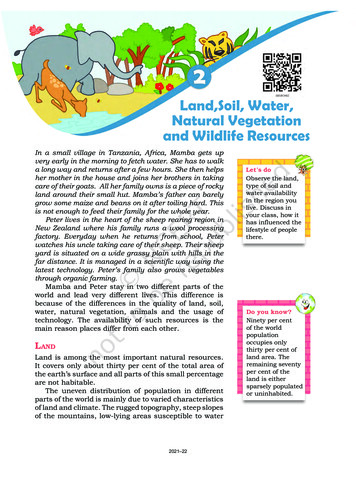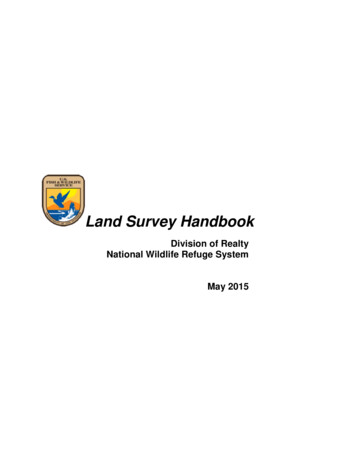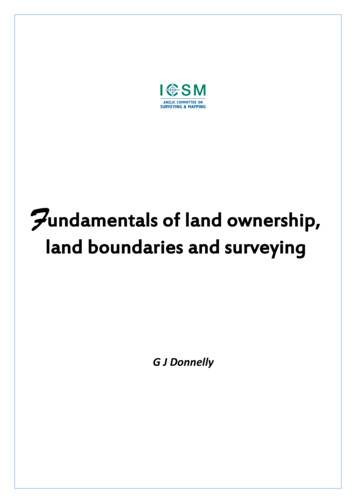
Transcription
Fundamentals of land ownership,land boundaries and surveyingG J Donnelly
About this documentThis document was commissioned and first published in 2012 by the ANZLIC Committee on Surveying andMapping (ICSM) to provide students and interested members of the public with an overview of key mattersrelating to the ownership of land and the boundaries that define the limitations of that ownership, including areview of the role of surveyors in the determination of land boundaries.As such, it does not purport to be a source of legal advice, nor is it intended to be a complete or absolute treatiseof the subject.About the authorGus Donnelly qualified and registered as a land surveyor in Tasmania in 1966, subsequently gaining considerableprofessional experience in a wide variety of public and private sector roles. In 1985, he completed a GraduateDiploma in Professional Management. He was appointed Chief Surveyor (Department of Main Roads, Tasmania)in 1986 and Manager Survey and Property (Department of Transport and Works, Tasmania) in 1991. From 1993,Gus moved into management roles in quality and continuous improvement, road maintenance and projectmanagement. He retired from full-time employment with the Tasmanian Government in 2000 and establishedhimself as a respected facilitation and project management consultant.Throughout his impressive career, Gus played a major role in the surveying profession, including: President, Institution of Surveyors Australia (Tasmanian Division) 1987-88 Member, Land Surveyors Board 1983–1991 Member, Board of Studies (University of Tasmania) 1985-1991 Member, Survey Industry Consultative Committee (University of Tasmania) 1985–1991 Federal Councillor, Institution of Surveyors, 1991–1994 Fellow, Institution of Surveyors, 1989 Facilitator, transfer of Surveyors Board responsibilities from the Tasmanian Government to theInstitution of Surveyors Australia (Tasmanian Division), 2004 Facilitator, ICSM Cadastral Reform Workshop, 2008.Other articles by the author include ‘Highways in Tasmania’, a paper dealing with legal aspects of the creationand ownership of highways in Tasmania, the rights and restrictions of land ownership and specific applications tohighways and adjoining lands, published in The Australian Surveyor, December 1986 (vol. 33 No. 4).AcknowledgementsThe author acknowledges and thanks the following people for their invaluable assistance and contributions to thedevelopment of this paper: Dr Jon Osborn, School of Geography and Environmental Studies, University of Tasmania, forencouragement, support, guidance and review Surveyor-General Bill Hirst, ACT Planning & Land Authority, for review and suggestions for improvement Former Surveyor-General Don Grant, Land Information New Zealand, for information and data related toNew Zealand Former Surveyor-General Peter Murphy and John VanderNiet of the Tasmanian Department of PrimaryIndustries, Parks, Water & Environment, for information, historical records and relevant data. G J Donnelly and ICSM 20141
ContentsIntroduction . 3Historical perspective . 3The relevance and importance of land ownership systems in a modern society . 3Concepts of land and land ownership . 4The meaning of ‘land’. 4The cadastre . 4Systems of ownership and registration. 5Freehold vs leasehold. 7Co-ownership of property . 7Ownership rights and obligations . 8Relevance of property boundaries to ownership . 8Land boundaries . 9Kinds of boundaries. 9Definition of boundaries of land parcels . 9The nature of boundaries. 10Home boundaries . 10Boundary disputes and judicial determination . 11Some interesting cases. 11Surveyors and Surveying . 13What Surveyors do . 13Evolution of surveying and surveying technology . 13Control of surveying standards and survey quality. 14Engaging the services of a registered or licensed surveyor . 15Finding a registered surveyor. 15Becoming a registered surveyor . 15Professional surveying bodies . 15Dealing with complaints and disputes . 15References . 16Useful websites . 16ANZ universities offering accredited surveying courses . 162
IntroductionHistorical perspectiveThe fundamentals of land ownership and land boundaries date back to the very roots of civilisation, andmatters relating to possession and control (ownership) of land are well documented in historical records.Indeed, the territorial control of land has been a fundamental issue in the rise and fall of empires throughouthistory (for example, the Roman Empire) and the cause of a great number of the world’s wars since thebeginning of civilisation.In the centuries BC, the importance of land ownership was focused on arable lands used for productiveagriculture, and even in those times there were issues associated with occupation and boundaries: “in 173 BCLucius Postumius Albinus, a statesman of the Roman Republic, was sent to Campania (a region in SouthernItaly) to separate the land of the state from that of private persons, because private land owners had slowlyexpanded their boundaries into public lands” (Lucius Postumius Albinus (Consul 173 BC) wiki 2011).Biblical references to the Land of Israel and its boundaries can be found in: Genesis 15; Exodus 23; Numbers 34;and Ezekiel 47 (Land of Israel wiki 2012). In fact, the boundaries of the Middle Eastern States have changedregularly throughout history.In more modern times, we continue to witness wars arising, in part, over control of territorial boundaries, forexample: the Six Day War in the Middle East in 1967 between Israel and Jordan, Egypt and Syria; and theBosnian War that took place between April 1992 and December 1995 as a result of the breakup of Yugoslavia.The relevance and importance of land ownership systems in a modern societyIn recent times, the importance of control of land (and a nation’s offshore and seabed maritime boundaries) ismore likely to be centred on rights of economic development and control of important resources, such as oiland fishing rights.In particular, our land tenure (manner of possession) system is fundamental to, and provides investor andcommunity confidence in: development planning, economic growth and sustainability social stability through housing and employment financial security in economic development and property markets natural resource and environmental management and sustainability.Land ownership systems also underpin: government policy making and program deliverytaxation, land administration and the distribution of electoral boundariesland use management and regulation.3
Concepts of land and land ownershipThe concept of land ownership – as Australia and New Zealand understand and practise it – is not universal andthere are many other forms of ‘ownership’ existing in different cultures throughout the world. Many are quiteinformal in the way they operate. In fact, our system is very formal and highly structured in comparison withdeveloping countries.The system used in Australia and New Zealand is a comparatively recent development in world history and isbased on ‘common law’ (that part of law developed over a long period of time by decisions of courts). Othercountries that use common law include Canada, Ireland, the United Kingdom and the United States of America.Common law principles can be overruled by ‘statute law’, which is established by legislative enactments such asActs or Regulations.Land under common law is said to be held in ‘fee simple’, which describes a form of ownership that can be heldby owners and their heirs indefinitely.The meaning of ‘land’Land is often referred to as ‘real property’, which, in very basic terms, means property that is fixed andimmovable – as distinct from personal property which, again in basic terms, means property (as in goods andchattels) that is not fixed and can be moved.The general principles of ownership at common law have long been established in the courts of equity,although the concept of extent of ownership has changed significantly in interpretation from the nineteenth tothe twenty-first century. In addition, statutory law continues to place increasing restrictions on the rights andbenefits that would otherwise accrue with land ownership (Donnelly 1985).“At common law, the term ‘land’ when used in relation to a particular parcel meant the surface of the Earth,the soil beneath the surface to the centre of the Earth and the column of air above the surface. It included allthings growing on or affixed to the soil, such as trees, crops and buildings. It also included all the minerals inthe soil excepting gold and silver, which at law belonged to the Crown as royal metals” (Hallmann 1994, 9.1).This concept in the twenty-first century is, however, subject to limitation by statutory law and comesincreasingly under challenge at common law.As examples, ownership of the air space above the land surface is qualified by Air Navigation legislation, andunregistered wayleaves and easements under Electricity Easements legislation. Apart from these and othersimilar statutory exceptions, the surface owner does own the airspace above their land in the sense that,subject to building regulations, they are fully entitled to extend their occupation of the air, for example, bybuilding high-rise developments. However, judgements in recent cases are interpreted to mean that anowner's rights extend only as far as is necessary for the ordinary use and enjoyment of their land.It should also be noted that “in all States (of Australia) there are statutory definitions of ‘land’ which lay downthe meaning to be ascribed to the term where it occurs in Acts of Parliament. These definitions do notmaterially interfere with the common law meaning except with regard to its use in Acts dealing with specificsubjects. For example, an Act which regulates mining would naturally introduce substantial qualifications onthe rights of an owner of land to take minerals from it” (Baalman 1979, p. 95).“Ownership also involves a significant element of possession (refer Possessory Title) and it can be stated thatownership of the land surface extends just so far in each direction upwards or downwards vertically as theowner is able to bring and retain under their effective control” (Donnelly 1985).The cadastreThe concept of ‘the cadastre’ is either unknown or not understood by the population at large. It is, however, avital tool used by professionals involved in land and land-related dealings.4
In plain English, a cadastre is an official register showing details of ownership, boundaries and the value of realproperty in a district, made for taxation purposes (Collins English Dictionary 1979).A cadastral map displays how boundaries subdivide land into units of ownership.The cadastre is used as the foundation for dealings in: Land valuation and taxation Land registration and land transfers Land use planning Sustainable development and environmental protection Mapping Management of leases and licences Electoral boundary determination and Other land-based administrative purposesDigital Cadastral DataBases (DCDBs) are modern versions of ‘the cadastre’ and provide spatial views of landparcels. Although based on paper plans, records and maps, DCDB information has been digitised to delivermaps that show digital coordinates of land parcels, as well as a great deal of supplementary informationrelated to the land.Systems of ownership and registrationOver history, many forms of land ownership (ie different ways of owning land) have been established. Landtenure can be defined as the mode of holding or occupying land (Burke 1976, p.323).Land tenure systems dealing with ownership of land in Australia and New Zealand include: General Law (‘Old System’) Title Torrens (‘Real Property’) Title Strata Title Native/Aboriginal Title and Maori Title, and Possessory Title.In Australia and New Zealand, land is predominantly held under the Torrens Title system, although remnants ofGeneral Law Title (deeds of conveyance) still remain. All land in the Australian Capital Territory is leasehold(effectively Torrens freehold) and much of the Northern Territory is held under Crown lease. Native/AboriginalTitle and Maori Title are recognised as separate forms of ownership by both Acts of Parliament and the Courtsof the land. Crown Land is ‘remaining’ land that is still held by the Crown.General Law TitleLand originally granted by the Crown was subsequently held and dealt with under the English general lawsystem of tenure through the issue of a deed of conveyance. All subsequent dealings with the landrequired verification of the validity of the deed under transfer by searching (at each and everytransaction) the previous chain of history of the deed for a period of up to 30 years preceding thetransfer, to ensure there was proof of a good root of title and that there were no legal impediments tothe effectiveness of the deed transfer.While this system operated well enough in the early days of settlement when transactions were simpleand few in number, it was soon realised that there was no guarantee that all the interests in the land hadbeen uncovered through recordings and/or searching, and that previous defects and deficiencies couldeasily pass to a new owner.Soon after, Registries of Deeds were established under various Acts of Parliaments to protect purchasersand mortgagees through the registration of all conveyancing transactions at a single State-controlledrepository, thus simplifying searching of land records for further dealings with parcels of land.However, it was quickly realised that, with a rapidly expanding population, there was a need for stillgreater surety and protection of the parties involved in land dealings, and that further simplification ofthe land tenure system was required.5
This led to development of the Torrens system of title, which is still in place today.Torrens TitleThe Torrens system of land title was devised by Sir Robert Torrens in South Australia in 1858, and wasactually based on the Lloyd’s of London shipping register.Its key feature is that it captures all interests in a property, including transfers, mortgages, leases,easements, covenants, resumptions and other rights in a single Certificate of Title which, once registeredwith the State by a Registrar General or Recorder of Titles, is guaranteed correct by the State.In other words, the register is conclusive evidence of ownership. This is known as the principle of‘Indefeasibility of Title’. Thus, there is no need to search behind or beyond the Certificate of Title toensure proven ownership of the land.It should be noted, however, that the State guarantee of ownership does NOT extend to the boundariesof the land shown in a title being correct.Strata Title“Strata Title is a form of ownership devised for multi-level apartment blocks and horizontal subdivisionswith shared areas. The ‘strata’ part of the term refers to apartments being on different levels, or‘strata’ Strata Title Schemes are composed of individual lots and common property. Lots are eitherapartments, garages or storerooms and each is shown on the title as being owned by a Lot Owner.Common Property is defined as everything else on the parcel of land that is not comprised in a Lot, suchas common stairwells, driveways, roofs, gardens and so on” (Strata Title wiki 2012).Native and Maori TitleIn Australia, native title is a common law concept that recognises “Aboriginal people have property rightsand interests in land arising from traditional law and custom. The traditional relationship to land is dualin character, having spiritual and material dimensions” (Rigsby 1999).Prior to this recognition, it was generally recognised that, at the time of British settlement, the doctrineof terra nullius prevailed: Australia was a “land belonging to no one”. This was rejected by the High Courtin 1992, where it was held that Australia recognises a form of native title, to be determined inaccordance with Indigenous law and custom (Mabo v Queensland No. 2).The rights to native title have also been enshrined in Acts of Parliaments, both Federal and State.For native title to exist in a particular area today, a number of conditions have to be satisfied:“When the Crown acquired sovereignty over the claimed area, which happened at differenttimes in different parts of Australia, there had to be an identifiable group of Aboriginal peopleinhabiting the claimed area, with traditional laws and customs giving rise to native title rights atthat timeThere must be an unbroken chain of inheritance or succession, in accordance with traditionalAboriginal laws and customs, from the original native titleholders to the present day claimantsThe Aboriginal laws and customs giving rise to the native title rights must have been observedand recognised continuously during that period, andThere must not have been an event that had the effect of extinguishing the native title rights,such as a valid freehold grant, or valid extinguishing legislation” (van Hattem 1997).In New Zealand, a totally different scenario unfolded following British settlement, in that the BritishCrown decided to negotiate with the Maori people to obtain sovereignty of the country, signing theTreaty of Waitangi in February 1840, which:“Ceded to the Crown of England all the powers of sovereignty exercised by the chiefs of thetribes of New Zealand6
Guaranteed to the Chiefs and tribes of New Zealand, and to the respective families andindividuals thereof, the full exclusive and undisturbed possession of their lands and estates,forests, fisheries and other properties which they may collectively or individually possess, solong as it is their wish and desire to retain the same in their possession, andGave the Maori people all the rights and privileges of British subjectsWith the signing of the Treaty, two systems of land law confronted each other – the Englishsystem and the indigenous Maori system. This created difficulties in land dealings and thetransfer of land, particularly as European settlement increased and settlers demanding landsought to buy it from Maori owners. This led to a series of disputes in the 1850s, and theestablishment of the Maori Land Court in 1865 to deal with disposal and transfer of traditionalMaori lands. Today, the English land law system prevails but not exclusively – the indigenousMaori system has not disappeared entirely” (LINZ, undated).Possessory Title (Adverse Possession)“Possession is prima facie evidence of ownership. ‘Possession is nine-tenths of the law’ means thatpossession is good against all the world except the true owner” (Burke 1976, p. 257).At common law, ownership may be claimed by an adverse occupier against the true owner of the land(limited to the land actually possessed and not a greater area held under the same title). The true owneris said to have been dispossessed and their rights of ownership are extinguished.For any claim to be successful, there are a number of basic requirements. There must be clear andirrefutable evidence that:“The possession was open, not secret; peaceful, not by force; and adverse, not by the consentof the true owner” (Hallmann 1994, 9.51)Actual possession of the property occurred for the required statutory period governed by therelevant statute of limitations (varies but generally accepted as 12 years), and was exclusive anduninterruptedThe occupant exercised all the rights of a true owner, for example through the payment of duerates and taxes, and by making improvements to the land or by cultivation or construction ofenclosures, and so on.Claims for adverse possession against the Crown are more limited and complex, and extend over muchlonger periods of time (30–60 years, depending on the circumstances of the possession). In some cases,there can be no adverse possession against the Crown (for example, in the case of crown reserves orreserved roads).Freehold vs leaseholdAlthough the vast majority of land in Australia and New Zealand is held under freehold tenure, leaseholdtenure does exist, that is ‘ownership’ held as a lease over a number of years.The best example is in the Australian Capital Territory, where land is held under leasehold title (generally as a99 year lease) but is effectively a Torrens freehold title.In other Australian States, particularly the Northern Territory, pastoral leases and other forms of Crown leasesform part of our land tenure system and are quite common.Co-ownership of property“Where two or more persons own the same property at the same time they are said to be co-owners thedifferent forms of ownership are said to be joint tenancy and tenancy in common” (Baalman 1979, p. 133).A joint tenancy is where land is held by more than one owner and there is a right of survivorship, ie if oneowner dies that owner’s interest in the land passes to the survivor(s) as a right in law – the deceased owner’sinterest in the property evaporates and cannot be inherited by their heirs. This is the most common form ofco-ownership between husband and wife, or parent and child, where parties want ownership to pass7
immediately and automatically to the survivor. Sale of property held under joint tenancy requires the jointconsent of all parties.Tenancy in common is where ownership of a property is held by owners who each have separate and distinctshares of the same property (generally in equal shares), but there is no right of survivorship, and an individualowner’s interest is capable of passing by inheritance to their heirs. Tenants may, subject to the agreementunder which the property is held, sell or otherwise deal their particular share without the consent of the othertenants. This form of ownership is most common where the co-owners are not married or have contributeddifferent amounts to the purchase of the property. The assets of a joint commercial partnership might be heldas a tenancy in common.Ownership rights and obligations“Ownership implies the right to exclusive enjoyment of a thing, and can be either ‘absolute’ (the right of freeand exclusive enjoyment, including the right using, altering, disposing of or destroying the thing owned) or‘restricted’ (ownership limited to some extent, which is the situation with land since it cannot be destroyed).Ownership is always subject to the rule that a person must use their property as not to injure their neighbour”(Burke 1976, p. 243).An owner in fee simple is entitled to use it in any manner they please, subject only to:i.ii.iii.iv.their obligations towards neighbours and the publicany condition which may have been imposed in the Crown grantobligations entered into by express agreement with others, andrestrictions and qualifications imposed by legislation (Baalman 1979, p. 98).Relevance of property boundaries to ownershipMarked boundaries are prima facie evidence of the legal extent of ownership of property and may be markedby natural boundaries, survey pegs or enclosed occupation such as fences, hedges or walls.However, occupation and described measurements of property ownership can often be misleading. What isreally required to determine the true nature of the boundary – what the boundary is, and where it is located –requires the services of a registered land surveyor.Determination of property boundaries is ultimately a matter for judgement by the Courts: the surveyor’s role isthat of an expert witness capable of discovering all evidence relevant to the location of the boundary.Property boundaries are dealt with more fully in the following section.8
Land boundariesKinds of boundariesBoundaries can be classified at many levels: they may be international (between countries), national (betweenstates of a country), regional (between regions of a state), local (between localities of a region or localgovernment area) or – as in the context of this paper – individual boundaries separating parcels of subdividedland.Boundaries between countries and states are more commonly referred to as borders, and may be eithernatural (eg. seas, rivers, lakes) or artificial (eg defined by geographic lines of latitude and longitude). Bordersserve political, legal and economic purposes in separation of the jurisdictions of abutting areas.Other kinds of boundaries include maritime boundaries, which define the exclusive rights of a country or stateover the resources of oceans adjoining the land of that country or state: In Australia, “a 3 nautical mile limit ofcoastal waters; a 12 nautical mile limit of the territorial sea, 24 nautical mile Contiguous Zone and a 200nautical mile limit of the Australian Exclusive Economic Zone” (Geoscience Australia, 2011). Maritimeboundaries may also exist for specific purposes, such as marine parks and fishing zones and ‘administrativeboundaries’, which are based on cadastral maps and used for political and governmental administrativepurposes (eg. electoral boundary divisions, censuses taken periodically for planning and development purposesat a national or regional level).Definition of boundaries of land parcelsBoundary lines (commonly called property lines) define the extent of the legal limits of ownership of any parcelof land.At common law, the rule of ‘marks (monuments) before measurements’ prevail in the definition of a boundary.There is also a presumption at common law that where land is described as being bounded by a road,ownership extends to the middle of the road (the ad medium filum viae rule), unless there is a clearly definedintent to the contrary (which is usually the case).If the description of a boundary is ambiguous, otherwise uncertain or in conflict with the occupations, Courtsmay settle the position of the disputed boundary. Courts have established precedents granting priorities ofweight where any two or more of the following boundary features present conflicting evidence in thedetermination of a true boundary position, in order of priority: “Natural boundaries (eg rivers, cliffs)Monumented lines (boundaries marked by survey or other defining marks, natural or artificial)Old occupations, long undisputed (for example an old wall or fence)Abuttals (a described ‘bound’ of the property eg a natural or artificial feature such as a street or road)Statements of length, bearing or direction (‘metes’ or measurements in a described direction)This ranking order is not rigidly adhered to; special circumstances may lead a court at times to givegreater weight than normal to a feature of lower rank” (Hallmann 1994, 13.13).Subject to any evidence to the contrary, Courts have consistently ruled in favour of long, acquiescent andundisturbed occupation dating to the time of survey as the mo
relating to the ownership of land and the boundaries that define the limitations of that ownership, including a review of the role of surveyors in the determination of land boundaries. As such, it does not purport to be a source of legal advice, nor is it intended to be a complete or absolute treatise .
